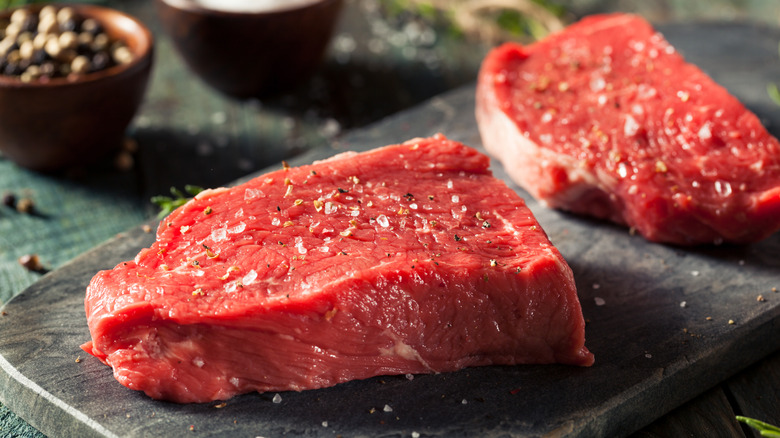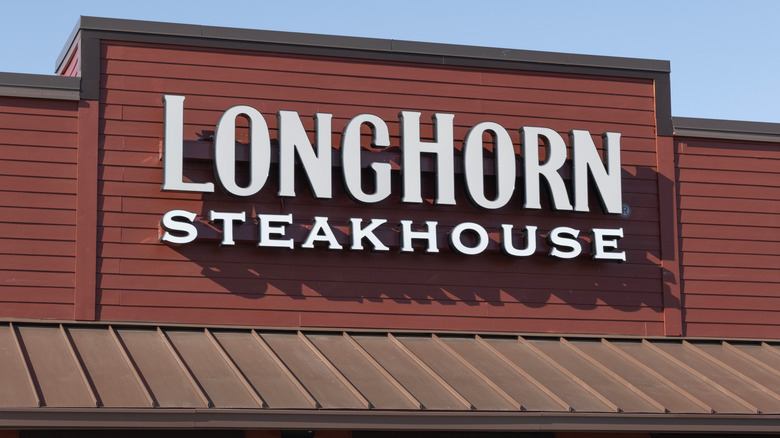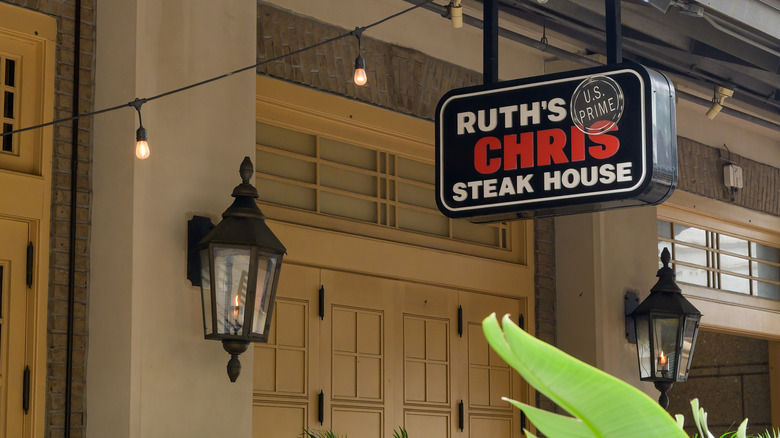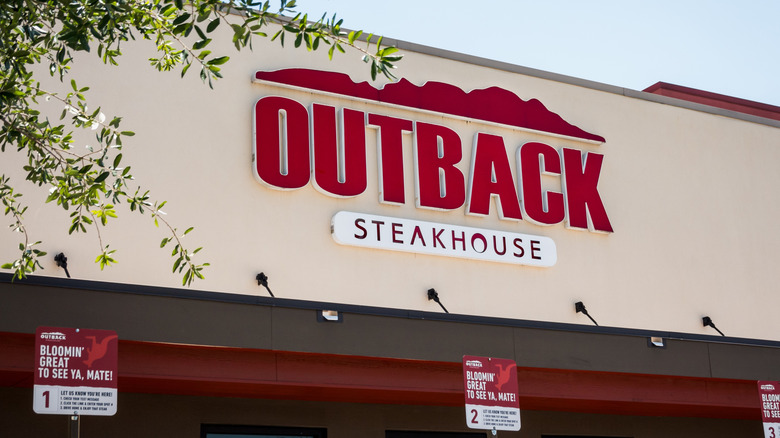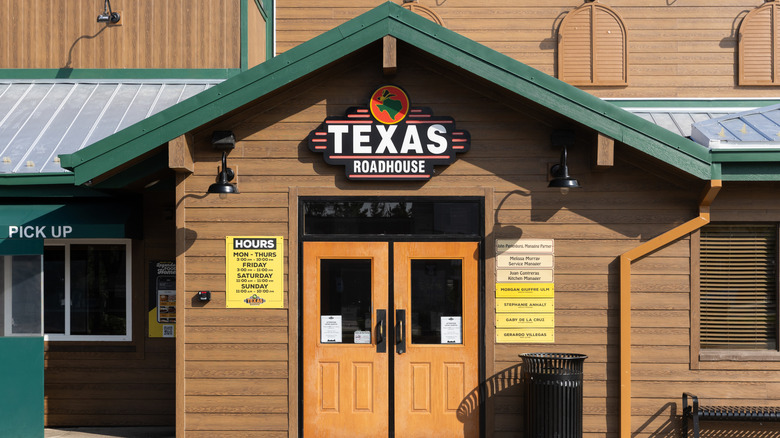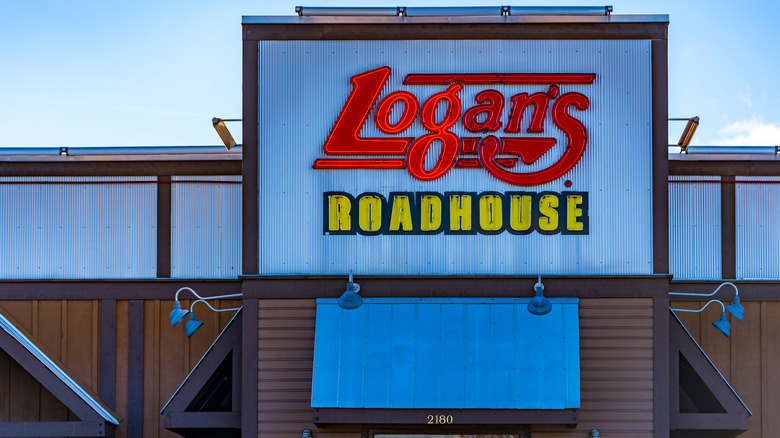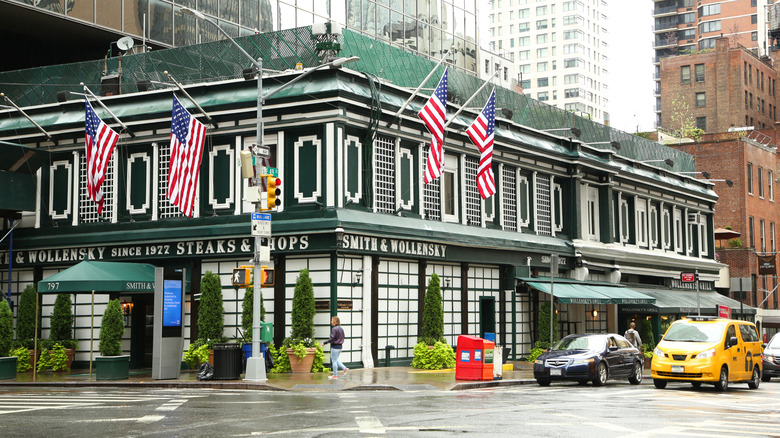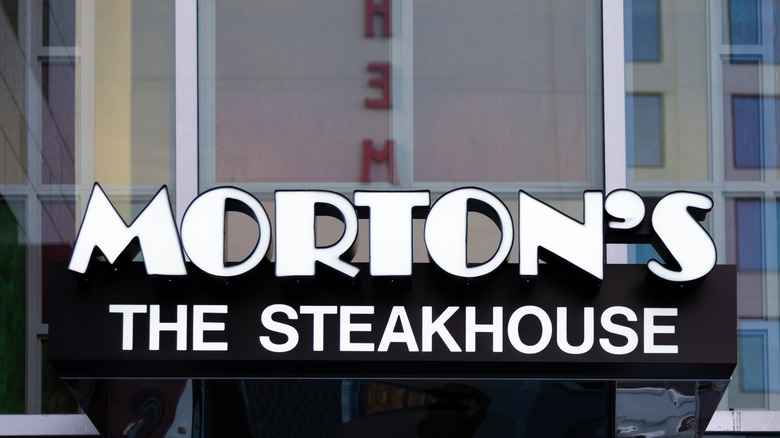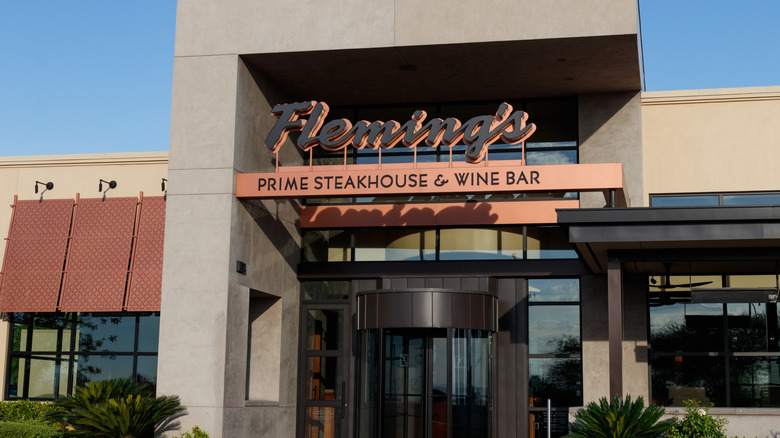Steakhouse Chains That Proudly Serve Never-Frozen Beef
When it comes to how we feel about frozen beef, it can be a tale of two halves. Most of us are pretty content to use thawed ground beef or burgers that have been sitting in our freezers for our home cooking. However, if you're eating out, you probably want the fresh kind, right? Unfortunately, even in 2025 some chain restaurants still resort to using frozen beef, despite the red flags it can have. While this can make sense on a food safety or preservation level, it can also feel like the place you're eating in is cutting corners and reducing quality — and if you're sitting in a steakhouse and paying top dollar for a hunk of beef, you likely want to know that the restaurant is working with the best product possible.
Well, luckily, there are plenty of steakhouse chains that do just that. It'll probably comfort you to know that some of the biggest steakhouse chains out there avoid serving beef that's been frozen in any form. Instead, they prioritize working with fresh, certified beef that's often butchered on-site before being aged to develop flavor and texture. If you're looking to get your money's worth, visiting these steakhouse chains is the way to go.
LongHorn Steakhouse
LongHorn Steakhouse is a pretty big business. There are almost 600 units of this chain dotted around the country, and millions of people walk through its doors each year and enjoy its steaks. So it's little wonder that a lot of people question how the brand keeps churning out beef day in, day out without resorting to the use of that most basic of food preservation techniques: Freezing. Incredibly, though, one of the brand's bannerhead promises is that it uses fresh, never frozen steaks, something it reiterated in a statement to Food Republic. "At LongHorn, we use high-quality steaks that are fresh, never frozen," a spokesperson said to the website.
LongHorn Steakhouse doesn't just use fresh steaks, though: It also uses good ones. The chain seeks to source the best-quality meat it can afford, and opts for classic cuts with abundant marbling that burst with flavor. One of the other reasons why LongHorn Signature steaks taste so good is because the prep work is relatively minimal: Rather than parcooking the steaks and then finishing them off, each piece of meat is cooked to order and totally customizable. We've gotta admit, we're pretty hungry now.
Ruth's Chris Steak House
We've always felt like Ruth's Chris Steak House is a cut above the rest. While there are some things that Ruth's Chris doesn't want you to know, this chain has a slightly more upmarket feel than joints like Sizzler, and this is reflected in how it treats its beef. Ruth's Chris is quick to point out that it uses beef that's never been frozen. It puts this claim on the menu itself, proudly displaying the info to its customers — so you know that it's serious about it.
On its website, Ruth's Chris Steak House goes into way more detail about where it gets its steaks from. The chain uses USDA Prime beef which it sources from some of the best beef suppliers in the country. The cows that provide the beef are reared on a combination of grass and corn, with the well-rounded diet improving its flavor and quality. The corn-fed nature of the beef gives it a sweetness and richness and creates a higher fat content in the meat itself, which then improves its marbling and tenderness. These attributes are often diminished when beef is frozen, which Ruth's Chris swears against. The chain provides steak that's at peak quality and arrives on your plate in the most direct way possible.
Outback Steakhouse
The thing about Outback Steakhouse is that it takes its meat very seriously. While it's reasonable to assume the steakhouse chain that created the Bloomin' Onion might have a, shall we say, slightly less refined approach to its food, its steak is only ever treated with maximum respect and never frozen. Outback Steakhouse steaks are only made with fresh beef (as well as fresh ingredients across the board) which undergoes a rigorous preparation process. After sourcing the steaks from the best suppliers, it then hand-trims and ages each piece of meat before seasoning them with the restaurant's signature spice blend. Then, every steak is cooked to order in accordance with the customer's preference.
If you thought that a big chain like Outback Steakhouse tried to save time elsewhere, too, you'd be wrong. The restaurant prides itself on preparing everything from scratch before it opens the doors each day, with salads made fresh and the soups cooked on site. As for that Bloomin' Onion, it's made by first bathing each onion in a water bath before forcing it into a special slicer that creates its flower-like shape. They're battered, dunked in a hot bath of oil, and then delivered to your table piping hot.
Texas Roadhouse
The thing about Texas Roadhouse is that if it really wanted to, it could probably justify freezing its beef. The iconic steakhouse has well over 700 restaurants dotted across the United States, and we're willing to guess that it could make the argument that freezing its meat would improve its operation or its safety — which is pretty appealing given the amount of customers it has. So it's pretty admirable that it avoids doing that entirely, and instead is very clear that it only ever works with fresh, never frozen steaks that it hand-cuts for every person eating. This is done by each restaurant's in-house butcher, who slices the meat on-site for maximum freshness.
If you had any further doubts about its freshness, it might comfort you to hear that this slicing is done in temperature-controlled conditions, with the butchers working in 34-degree coolers to do so. (We hope that the restaurants give them coats to work in, but that's just by the by.) Texas Roadhouse doesn't stop there, either: It also employs a baker in each restaurant, who prepares and cooks the chain's famous yeast rolls daily. These rolls are baked every five minutes and served when still warm to its customers. This is a chain that really values freshness, folks.
Logan's Roadhouse
Logan's Roadhouse has the feel of a down to earth neighborhood joint, despite the fact that the Nashville-based chain now has a pretty big footprint. Well, we're pleased to see that despite its growing size, it hasn't lost sight of what its customers want — and that's fresh beef. Logan's Roadhouse only uses fresh, never frozen steaks, which it sources from only the best cattle. The steaks are hand-cut, wood-fire grilled, and seriously tasty.
Like many other steakhouse chains, Logan's opts for USDA Choice beef from Midwestern sources. Its steaks are hand-cut by its own professional meat cutters, which gives the chain the ability to slice to its own specifications and not produce identical-looking pieces of beef that feel (and taste) anonymous. Its beef is corn-fed for maximum flavor and aged in-house, giving it greater control over its flavor. Oh, and when it comes to frozen meat, the same rules apply to its chicken: Its grilled and breaded chicken dishes are always fresh. Plus, its soups, salad dressings, chilis, and its yeast rolls are all made from scratch. Trust us, you could do far worse than eating at Logan's.
Del Frisco's Double Eagle Steak House
Del Frisco's Double Eagle Steak House has a pretty fancy feel to it. Despite being a sizable chain, each steakhouse feels stately and elegant — and you'd expect the food to feel the same. Well, Del Frisco's doesn't let you down in that department, especially when it comes to its steak. It doesn't resort to the same shortcuts that other steakhouse chains might, and instead only serves never frozen beef.
Each steak at Del Frisco's is USDA Prime certified and corn-fed for maximum flavor and marbling. The steaks are sliced to order, generously seasoned, and then cooked from room temperature in a searing hot skillet. It's the combination of quality ingredients and technique that really hits the spot here. Oh, and if you were wondering if Del Frisco's keeps its other dishes and ingredients just as classy, you'll be pleased to hear that everything else is also made in-house, from its soups to its bread. Even its salad dressings and sauces are whipped up on-site instead of being shipped in vacuum-sealed bags to each location. We admire that commitment to freshness, even if it'll cost you a pretty penny.
Smith and Wollensky
For a chain that dubs itself "America's steakhouse," you'd hope that Smith and Wollensky treats its countryfolk with respect, right? Thankfully, in the steak department, it certainly does. Smith and Wollensky is well aware that the success of a steakhouse starts with its meat, and it's keen to stress that it only works with the freshest beef, and the freshest ingredients overall. No freezing going on here, folks.
If you had any doubts about the origins of its beef, too, you really shouldn't: Smith and Wollensky puts all the info you need right there on the menu. The chain only works with USDA Prime Black Angus beef reared in Iowa and fed on a diet of corn. Its beef is supplied by Iowa Premium, a producer that works with family farms to ensure the best quality possible to the restaurants it works with. Smith and Wollensky's steaks then undergo a 28-day dry aging process, which gives the meat a mellower, more intense flavor and a softer texture. As with other steakhouses, it's also hand-cut on site, giving each piece of steak an individuality which translates to the plate.
Steak 48
Steak 48 is far from the biggest chain out there, with just six locations across the country. This smaller size allows it to focus more intently on the quality of its product and specifically its steak, which stays far away from the freezer before being cooked. The quickest of glances at its website reinforces how much care it puts into each steak, with the meat sliced in-house in climate controlled conditions. As well as using USDA Prime certified beef, Steak 48 also uses Australian Wagyu and Japanese A5 beef, with the latter's grading ensuring that it's the best quality meat out there.
The combination of high-grade meat and a lack of freezing means that the texture of each steak remains as superb as possible. A steak's tenderness is typically determined by its marbling, and while freezing beef doesn't inherently reduce its fat content, the formation of ice crystals in the meat can disrupt its natural texture. By avoiding the freezer, you're getting the meat in its best form possible — although Steak 48 does also wet-age and dry-age its steak to improve its texture and flavor even further.
Morton's
Ever since Morton's opened in 1978 in Chicago, it's focused on one thing above all others: Quality. Even the growth of the business into a chain encompassing over 65 restaurants hasn't thrown it off-course, and while it could have started to look for places to make its life easier, it doesn't do that with its beef. Instead, its meat is treated with love and care, arriving fresh at all of its locations and undergoing significant preparation before it gets to the table. The USDA Prime beef is aged for almost a month and sliced by hand.
Morton's has used the same supplier for its beef ever since it first threw open its doors, giving it a consistency that's hard to replicate in other, bigger chains. The meat is reared and selected with marbling in mind, giving it way more flavor. If beef isn't your thing (and we'd have to question why you ended up at a steakhouse if that were the case), Morton's also prides itself on the quality of its seafood, which it again selects to provide the best quality to its customers. It may not be the cheapest steakhouse out there, but you'll likely get a very good meal out of it.
Fleming's
Like many other upmarket steakhouse chains, Fleming's doesn't skimp when it comes to the quality of its meat. The restaurant dubs itself a Prime steakhouse and only works with fresh USDA Prime beef, which is bought from family-fun outfits based in the Midwest. The cattle that provide the beef are fed a corn-based diet for well over six months, giving the meat substantial marbling that translates to substantial flavor. The beef is then dry-aged or wet-aged, depending on the eventual desired result, and then sliced and delivered to Fleming's restaurants, before being further trimmed down to the ideal shape.
That's all before the chefs at Fleming's cook the meat, too. The steaks are seasoned simply but thoroughly, and are then thrown onto a char-broiler that's heated to a temperature of — wait for it — 1,600 degrees Fahrenheit. This astonishingly high temperature gives each steak a thick, intensely flavored crust while locking in its natural moisture. After being cooked to your specification, it's then served on a heated plate (which is warmed to 350 degrees, just in case you were wondering; Fleming's really goes hard on the details here). This all may sound a little fussy, but the result of all that detail is the best steak you've probably ever had in your life.
Static Media owns and operates Daily Meal and Food Republic.
